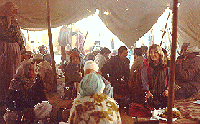
|
kilim-warehouse.com - brochure
|

 |
Although haggling over the price of a rug in an Eastern bazaar may be an appealing thought, are you ever sure that you have made a good buy? Our buyer, José Luczyc-Wyhowska (co-author of Kilim - The Complete Guide, published by Thames & Hudson) knows her kilims, and most importantly the price that should be paid. We are here to help you find the right kilim, and to give you comprehensive information about kilims. |
| kilim-warehouse.com is the new international name of The Kilim Warehouse Ltd (previously in London, UK, established 1982) and is a specialist importer of kilims and flat weave rugs. Each kilim is personally selected with the greatest attention given to the quality of weaving, design and colour harmony. Our aim is to source the best of every type of kilim, whether brand new, semi-old (10 - 50 years) or antique (100 years +), and save you the search through the many countries where kilims are woven. |  |
|
Whether you are discovering kilims for the first time, or are a connoisseur, your eyes will doubtless be drawn to the variety of wonderful colours found in old kilims. Many large size old kilims tend to be long and thin, because they were woven on narrow looms, whereas new kilims are made in more regular proportions. Due to the fact that there was little trade in kilims until they were 'discovered' in the 1970s, far fewer old kilims survived than knotted carpets. Antique and even semi-old kilims are becoming harder to source, however there are some excellent new kilims being woven, some of which are made in the traditional way with hand spun wool and natural colours. These will become the antiques of the future. Many of the new production kilims in our stock are commissioned by us. We try to encourage weavers to continue the tradition of making kilims, so that this ancient skill is not lost forever. |
 |
|
Kilims have been woven for many centuries, hand made by nomads and villagers for their own use, as part of girls' dowries, and for donation to mosques. The word kilim describes a flat woven rug, with a smooth surface and no pile. The spelling and pronunciation of kilim varies according to country of origin. Other flat weave rugs also have generic names due to variation of weaving techniques, e.g. cicim (pronounced gee-jim) zili, verneh, soumak. The tradition of weaving kilims and flat weave rugs still continues, but on a diminishing scale as far as village and nomadic production is concerned. Commercial production of kilims for the export market started around 1983 and is now prolific. Before that time there were plenty of kilims available, particularly as their commercial potential had not been widely recognized. Kilim designs are 'purer' than those of pile rugs, in the sense that they have survived the centuries with no interference from commercial pressure. These traditional designs have been handed down, young girls taught by their mothers and grandmothers. What you see when you look at kilims is an ancient art form - be it a brand new kilim, or an antique one - a kilim is not only a rug that goes with the decor. |
 |
 |
The variation in design and colouring of kilims is immense, every kilim is unique, even with new production, no two are identical. The same hands will always vary the design or colour combinations, even without intention to do so. Kilims are usually made from sheep's wool, but cotton is sometimes used for the warps, and if pure white is desired as a colour. Horse, goat and camel hair can also be used. Nomads and villagers shear their sheep twice yearly, the fleece is washed, combed and spun into wool that is then dyed. In the past only natural elements were used as dyestuffs, but since the advent of chemical dyes in 1863, the use of natural dyes went into decline because the new dyes were much easier to use. |
|
Within any colour found in kilims you will find variations in the tone, and sometimes a much lighter/darker hue of the same colour. This is know as 'arbrash' and is not a fault in the rug. Arbrash occurs because wool is only dyed in small quantities in the home, and two dye lots seldom come out with the same intensity of hue. Also where the hank of wool is tied to stop tangling in the dye bath, the dye penetrates less, so a lighter shade is achieved. These variations of colour add perspective to areas of the rug without motifs, which would otherwise look flat if the tone was consistent. There are many different techniques for weaving a rug with a smooth surface, however, in simple terms, the wefts, or horizontal threads are wrapped around the warps, or vertical threads, to create a woven textile whose quality is dependent on the materials used and skill of weaving. |
 |
|
Whatever your requirements may be, we can usually find something suitable from our diverse collection of kilims and flat weave rugs from Turkey, Iran, Eastern Europe, The Russian Caucasus and Afghanistan. We look forward to hearing from you on our online service. We are here to help. kilim-warehouse.com Orixa, Abrollido, Donas, 36388 Gondomar, Spain |